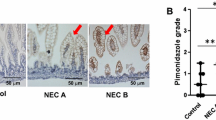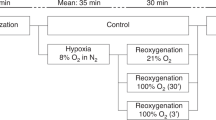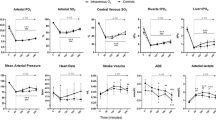Abstract
We utilized a newborn rat model of hypoxia/reoxygenation (H/R) that resembles human necrotizing enterocolitis (NEC) to investigate the effects of omeprazole and/or gentamicin on the formation of free oxygen radicals (FOR) and bowel histopathology. For H/R, 1-day-old rats were placed into a chamber of 100% CO2 for 5 min, then they were reoxygenized for the next 5 min. The rats (n=70) were divided into seven groups: group 1 (control), group 2 (H/R), group 3 (omeprazole), group 4 (H/R+omeprazole), group 5 (gentamicin), group 6 (H/R+gentamicin), group 7 (H/R+omeprazole+gentamicin). Gentamicin and/or omeprazole were given orally for 3 days, then all animals were killed; bowel specimens were harvested. Histopathologic injury scores (HIS) and malonyldialdehyde (MDA) and XO/(XO+XDH) rates (XO; xanthine oxidase, XDH; xanthine dehydrogenase) were measured, which reflect the FOR levels. In group 2, the HIS was significantly higher than groups 4 and 6. The mean MDA values in groups 1–7 were as follows: 54.16, 104.2, 56.85, 63.43, 62.31, 76.85, 79.13, respectively. The mean XO/(XO+XDH) levels were 0.306, 0.461, 0.286, 0.335, 0.323, 0.410, 0.375 from groups 1 –7, respectively. Group 2 rats had significantly more MDA and XO/(XO+XDH) rates versus other groups (P<001). Histopathologic injury and biochemical results were significantly more severe in group 2 than in groups 4 and 6 (P<001). There was no difference between groups 1 and 4 according to XO/(XO+XDH) rates. In newborn rats, H/R produces FOR, which cause serious intestinal damage. Omeprazole and/or gentamicin reduce biochemical and histopathologic bowel damage. This effect was more obvious in omeprazole treated rats. We think omeprazole may open new insights into the treatment of H/R related bowel injuries like NEC.



Similar content being viewed by others
References
Kosloske AM (1984) Pathogenesis and prevention of necrotizing enterocolitis: a hypothesis based on personal observation and a review of the literature. Pediatrics 74:1086–1092
Hsueh W, Caplan MS, Qu XW (2002) Neonatal necrotizing enterocolitis: clinical considerations and pathogenetic concepts. pediatric and developmental pathology 6:6–23
Kliegman RM, Walker WA, Yolken RH (1993) Necrotizing enterocolitis: research agenda for a disease of unknown etiology and pathogenesis. Pediatric Res 34:701–708
Caplan MS, Hedlund E, Adler L, Hsueh W (1994) Role of asphyxia and feeding in neonatal rat model of necrotizing enterocolitis. Pediatr Pathol 14:1017–1028
Musemeche C, Kosloske AM, Bartow SA, Umland ET (1986) Comparative effects of ischemia, bacteria, and substrate on the pathogenesis of intestinal necrosis. J Pediatr Surg 21:536–538
Caplan MS, Sun XM, Hsueh W (1990) Hypoxia casuses ischemic bowel necrosis in rats: The role of platelet-activating factor (PAF-Acether). Gastroenterology 99:979–986
Kliegman RM, Fanaroff AA (1984) Neonatal necrotizing enterocolitis. N Engl J Med 310:1093–1103
Crissinger KD, Granger DN (1989) Mucosal injury induced by ischemia reperfusion in the piglet intestine: influences of age and feeding. Gastroenterology 97:920
Okur H, Kucukaydin M, Kose K, Kontas O, Dogan P, Kazez A (1995) Hypoxia-induced necrotizing enterocolitis in the immature rat: The role of lipid peroxidation and management by Vitamin E. J Pediatr Surg 30:1416–1419
Mackendrick W, Caplan MS (1993) Necrotizing enterocolitis: new thoughts about pathogenesis and potential treatments. Pediatr Clin North Am 40:1047–1059
Grisham MB, Hernandez LA, Granger DN (1986) Xanthine oxidase and neutrophil infiltration in intestinal ischemia. Am J Physiol 251:567–574
Catty MG, Schmeling DJ, Friedl HP, Oldham KT, Guice KS (1990) Histamine: a promoter of xanthine activity in intestinal ischemia/ reperfusion. J Pediatr Surg 25:218–223
Hirata Y, Taguchi T, Nakao M, Yamada T (1996) The relationship between the adenine nucleotide metabolism and the conversion of the xanthine oxidase enzyme system in ischemia- reperfusion of the rat small intestine. J Pediatr Surg 31:1199–1204
Lucas A, Cole TJ (1990) Breast milk and neonatal necrotizing enterocolitis. Lancet 336:1519–1523
Bell MJ (1973) Neonatal necrotizing enterocolitis in infancy: prevention of perforation. J Pediatr Surg 8:601
Megison SM, Horton W, Chao H, Walker PB (1990) Prolonged survival and decreased mucosal injury after low dose enteral allopurinol prophylaxis in mesenteric ischemia. J Pediatr Surg 25:917–921
Parks DA, Williams TK, Beckman JS (1988) Conversion of xanthine dehydrogenase to oxidase in ischemic rat intestine: a reevaluation. Am Physiol Soc 768–774
Okhawa H, Ohishi N, Yagi, K (1979) Assay for lipid peroxides in animal tissues by TBA reaction. Anal Biochem 95:351–358
Huesh W, Caplan MS, Tan X, Mackendrick W, Crussi FG (1998) Necrotizing enterocolitis of the newborn: Pathogenetic Concepts in Perspective. Pediatr Dev Pathol 1:2–16
Sencan A, Yılmaz O, Özer E, Gunsar C, Genc K (2003) Does sucralfate prevent apoptosis occurring in the ischemia/ reperfusion induced intestinal injury? Eur J Pediatr Surg 13:231–235
Kazez A, Kucukaydın N, Kucukaydın M, Kontas O, Okur H (1997) A model of hypoxia- induced necrotizing enterocolitis: The Role of Distention. J Pediatr Surg 32:1466–1469
Nowicki P (1990) Intestinal ischemia and necrotizing enterocolitis. J Pediatr 117:14–19
Bell MJ, Ternberg JL, Feigin RD, Keating JP (1978) Neonatal necrotizing enterocolitis. Ann Surg 187:1–7
Egan EA., Mantilla G, Nelson RM, Eitzman DV (1976) A prospective controlled trial of kanamicin in the prevention of neonatal necrotizing enterocolitis. J Pediatr 89:467–470
Barlow B, Santulli TV, Heird WC, Pitt J, Blanc WA, Schullinger JN (1974) An experimental study of acute neonatal enterocolitis- The importance of breast milk. J Pediatr Surg 5:587–595
Bertram G. Katzung (2001) Proton pumps inhibitors basic and clinical pharmacology. Lange. 8 th edition 1067
Horn J (2000) The proton- pump inhibitors: similarities and differences. Clin Ther 22:266–280
Biswas K, Bandyopadhyay U, Chattopadhyay I, Varadaraj A (2003) A novel antioxidant and antiapoptotic role of omeprazole to block gastric ulcer through scavenging of hydroxyl radical. J Bio Chem 10993–11001
Wandall JH (1992) Effects of omeprazole on neutrophil chemotaxis superoxide production, degranulation, and translocation of cytochrome b−245. Gut 33:617–621
Suzuki M, Mori M, Miura S, Suematsu M, Fukumura D (1996) Omeprazole attenuates oxygen- derived free radical production from human neutrophils. Free Radical Biol and Med 21:727–731
Boyle R, Nelson JS, Stonestreet BS, Peter G, William O (1978) Alterations in stool flora resulting from oral kanamycine prophylaxis of necrotizing enterocolitis. J Pediatr 93:857–861
Egan EA (1977) Additional experience with routine use of oral kanamycin prophylaxis for necrotizing enterocolitis in infants Under 1500 grams. J Pediatr 90:331
Hansen TN, Ritter DA, Speer ME, Kenny JD (1980) A randomized, controlled study of oral gentamicin in the treatment of neonatal necrotizing enterocolitis. J Pediatr 97:836–838
Neu J, Masi M, Stevenson DK, Kwong LK (1981) Effects of asphyxia and oral gentamicin on intestinal lactase in the suckling rat. Pediatr Pharmacol 1:215–220
Rowley MP, Dahlenburg GW (1978) Gentamicin in prophylaxis of neonatal necrotizing enterocolitis. Lancet 2:532
Author information
Authors and Affiliations
Corresponding author
Rights and permissions
About this article
Cite this article
Biçakçi, Ü., Tander, B., Aritürk, E. et al. Effects of omeprazole and gentamicin on the biochemical and histopathological alterations of the hypoxia/ reoxygenation induced intestinal injury in newborn rats. Ped Surgery Int 21, 800–805 (2005). https://doi.org/10.1007/s00383-005-1538-y
Accepted:
Published:
Issue Date:
DOI: https://doi.org/10.1007/s00383-005-1538-y




